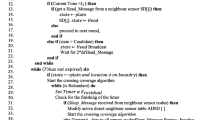Abstract
Many of today’s computing and communication models are distributed systems that are composed of autonomous computational entities that communicate with each other, usually by passing messages. Distributed systems encompass a variety of applications and wireless sensor networks (WSN) is an important application of it. The tiny, multiple functionality and low power sensor nodes are considered to be interconnected in the WSN for efficient process of aggregating and transmitting the data to the base station. The clustering-based schemes of sensor networks are capable of organizing the network through the utilization of a specifically designated node termed as the cluster head for the objective of energy conservation and data aggregation. Further, the cluster head is responsible for conveying potential information collected by the cluster member nodes and aggregate them before transmitting it to the base station. In this paper, a Reliable Cluster Head Selection Technique using Integrated Energy and Trust-based Semi-Markov Prediction (RCHST-IETSMP) is proposed with the view to extend the lifetime of sensor networks. This proposed RCHST-IETSMP incorporated two significant parameters associated with energy and trust for effective selection of cluster head facilitated through the merits of Semi-Markoc prediction integrated with the Hyper Erlang distribution process. The simulation results of the proposed RCHST-IETSMP scheme is proving to be efficient in upholding the residual energy of the network and the throughput to a maximum level of 23% and 19% predominant to the trust and energy-based clustering schemes considered for investigation.











Similar content being viewed by others
References
Zhu, R., Ma, M., Zhang, Y., & Hu, J. (2015). Collaborative wireless sensor networks and applications. International Journal of Distributed Sensor Networks, 11(8), 352761.
Jia, Y., Zhang, C., & Liang, K. (2017). A distributed multi-competitive clustering approach for wireless sensor networks. International Journal of Wireless Information Networks, 24(4), 454–461.
Tuna, G. (2017). Clustering-based energy-efficient routing approach for underwater wireless sensor networks. International Journal of Sensor Networks, 1(1), 1.
Pandey, S. (2017). Energy efficient clustering techniques for wireless sensor networks-a review. International Journal of Scientific Research and Management, 1(1), 43–56.
Liu, X. (2012). Sensor deployment of wireless sensor networks based on ant colony optimization with three classes of ant transitions. IEEE Communications Letters, 16(10), 1604–1607.
Chaturvedi, A., Goswami, D., & Singh, S. (2016). Energy efficient cluster head selection for cross layer design over wireless sensor network. International Journal of Communication Networks and Distributed Systems, 16(4), 335.
Deosarkar, B. P., Yadav, N. S., & Yadav, R. P. (2010). Distributed clustering with restricted number of cluster heads for energy efficient data gathering in wireless sensor networks. International Journal of Engineering and Technology, 2(1), 7–16.
Huang, J. (2017). Research on balanced energy consumption of wireless sensor network nodes based on clustering algorithm. In 2017 International Conference on Computer Network, Electronic and Automation (ICCNEA), 1(1), 23–34.
Kheireddine, M., & Abdellatif, R. (2014). Analysis of hops length in wireless sensor networks. Wireless Sensor Network, 06(06), 109–117.
Mbowe, E. J., & Oreku, S. G. (2014). Quality of service in wireless sensor networks. Wireless Sensor Network, 06(02), 19–26.
Bhuyan, B., Sarma, H. K., Sarma, N., Kar, A., & Mall, R. (2010). Quality of service (QoS) provisions in wireless sensor networks and related challenges. Wireless Sensor Network, 02(11), 861–868.
Deva Sarma, H. K., Mall, R., & Kar, A. (2016). E2R2: Energy-efficient and reliable routing for mobile wireless sensor networks. IEEE Systems Journal, 10(2), 604–616.
Vinu, S. (2019). Optimised denoising scheme via opposition-based self-adaptive learning PSO algorithm for wavelet-based ECG signal noise reduction. International Journal of Biomedical Engineering and Technology, 31(4), 325.
Vinu, S., Selvi M., & Kumar, R. S. (2018). An optimal cluster formation based energy efficient dynamic scheduling hybrid MAC protocol for heavy traffic load in wireless sensor networks. Computers & Security, 77, 277–288.
Vinu, S. (2019). Optimal task assignment in mobile cloud computing by queue based ant-bee algorithm. Wireless Personal Communications, 104(1), 173–197.
Selvi, M., Thangaramya, K., Ganapathy, S., Kulothungan, K., Nehemiah, H. K., & Kannan, A. (2019). An energy aware trust based secure routing algorithm for effective communication in wireless sensor networks. Wireless Personal Communications, 105(4), 1475–1490.
Sarma, H. K., Kar, A., & Mall, R. (2016). A hierarchical and role based secure routing protocol for mobile wireless sensor networks. Wireless Personal Communications, 90(3), 1067–1103.
Thippeswamy, B. M., Reshma, S., Tejaswi, V., Shaila, K., Venugopal, K. R., & Patnaik, L. M. (2015). STEAR: Secure trust-aware energy-efficient adaptive routing in wireless sensor networks. Journal of Advances in Computer Networks, 3(2), 146–149.
Rehman, E., Sher, M., Naqvi, S. H., Badar Khan, K., & Ullah, K. (2017). Energy efficient secure trust based clustering algorithm for mobile wireless sensor network. Journal of Computer Networks and Communications, 2017(1), 1–8.
Kumar, N., Singh, Y., & Singh, P. K. (2017). An energy efficient trust aware opportunistic routing protocol for wireless sensor network. International Journal of Information System Modeling and Design, 8(2), 30–44.
Miglani, A., Bhatia, T., Sharma, G., & Shrivastava, G. (2017). An energy efficient and trust aware framework for secure routing in LEACH for wireless sensor networks. Scalable Computing: Practice and Experience, 18(3), 67–76.
Bozorgi, S. M., & Bidgoli, A. M. (2018). HEEC: A hybrid unequal energy efficient clustering for wireless sensor networks. Wireless Networks, 1(2), 56–69.
Udhayavani, M., & Chandrasekaran, M. (2018). Design of TAREEN (trust aware routing with energy efficient network) and enactment of TARF: A trust-aware routing framework for wireless sensor networks. Cluster Computing, 1(1), 45–59.
Author information
Authors and Affiliations
Corresponding author
Additional information
Publisher's Note
Springer Nature remains neutral with regard to jurisdictional claims in published maps and institutional affiliations.
Rights and permissions
About this article
Cite this article
Famila, S., Jawahar, A., Vimalraj, S.L.S. et al. Integrated Energy and Trust-Based Semi-Markov Prediction for Lifetime Maximization in Wireless Sensor Networks. Wireless Pers Commun 118, 505–522 (2021). https://doi.org/10.1007/s11277-020-08028-0
Accepted:
Published:
Issue Date:
DOI: https://doi.org/10.1007/s11277-020-08028-0




